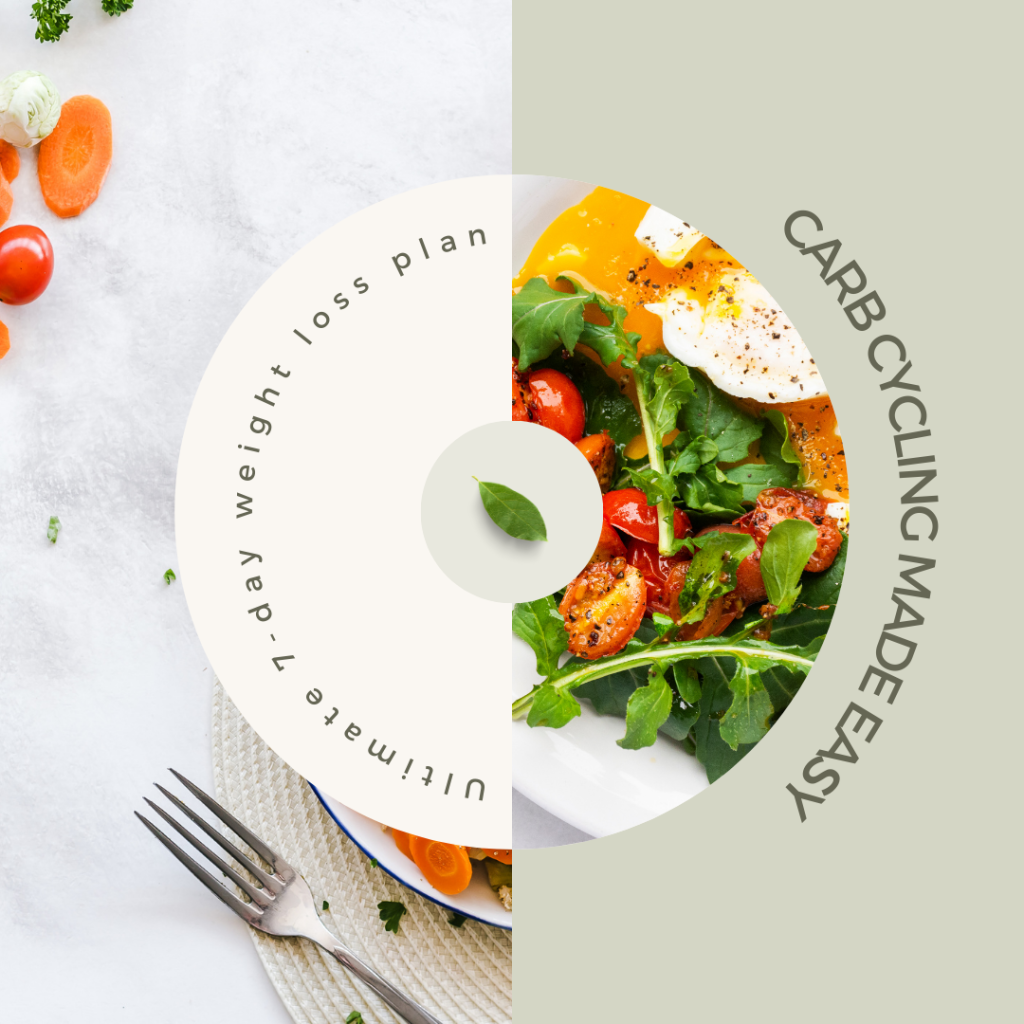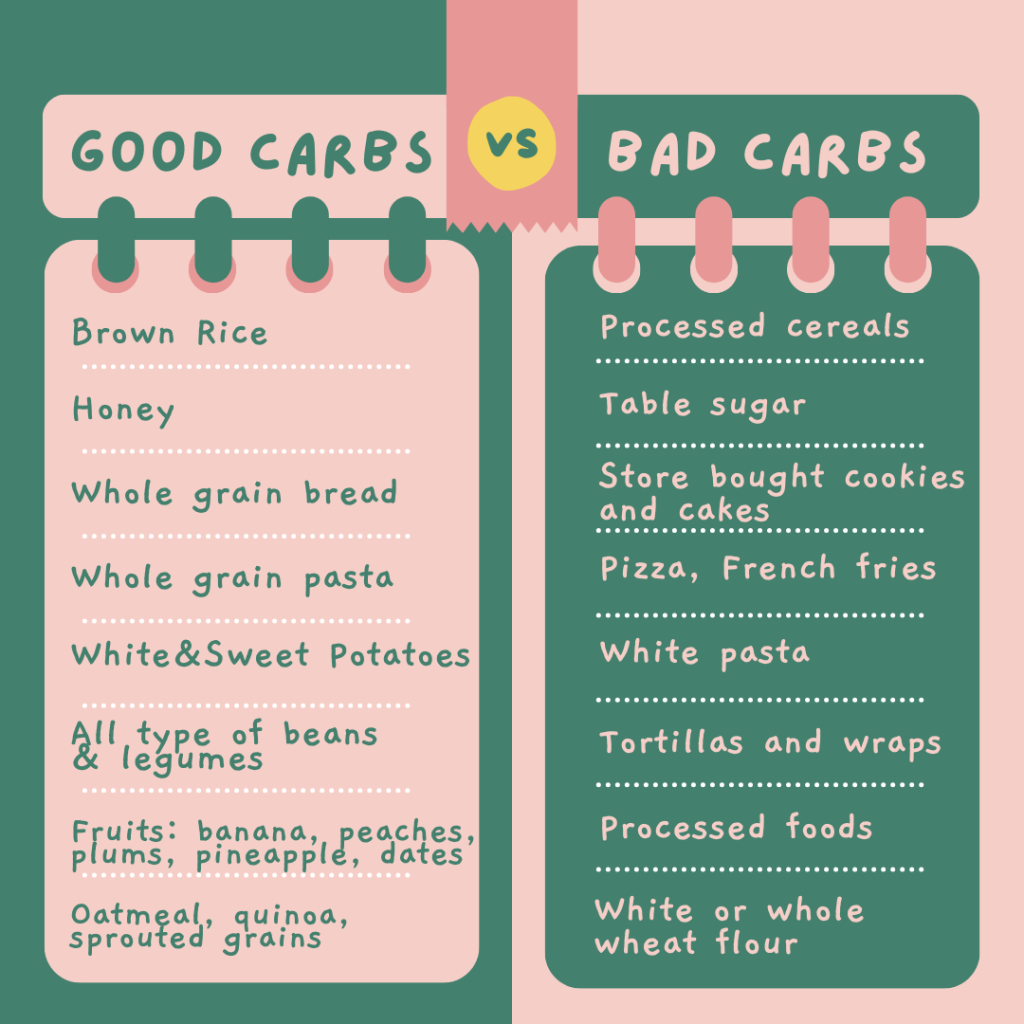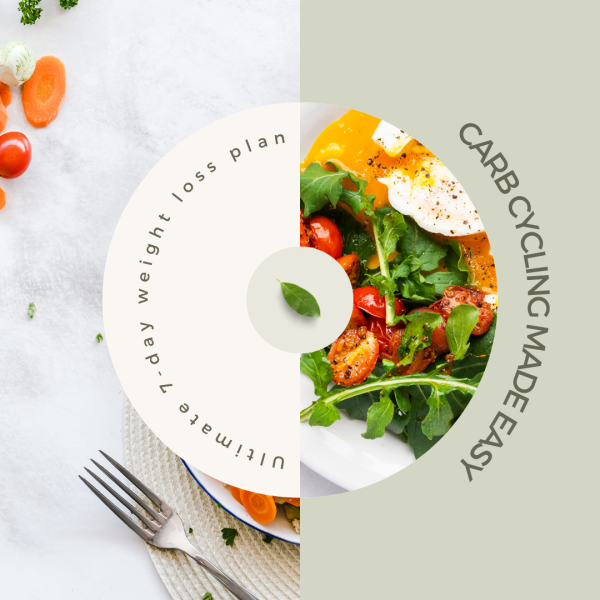
How to use carbs to burn fats?
For anyone trying to lose weight, the phrase “How to use carbs to burn fats?” might sound like an oxymoron. Carbs have long been vilified as the arch-enemy of dieters, synonymous with excess calories and weight gain. This traditional belief has led many classic diets to impose strict restrictions on carb-rich foods, even those considered healthy, like starchy vegetables and whole grains. As a result, the prevailing notion is that carbs not only impede weight loss but also pose risks to our health.
Well, science has recently turned that belief upside down by telling us that carbs may be your best ally in the battle to lose weight. Leveraging carbs to help us lose weight is called carb cycling. It is a method whereby eating carbs can lead to weight loss rather than weight gain! Carb cycling is done through a weekly eating plan with a few basic rules to stick to. Other than that, you have a full rundown of what you eat. Your meal plans can consist of all your favorite healthy foods, including carbs. You even have cheat days to indulge in your less healthy favorites to satisfy your cravings!
What Sets Apart the 7-Day Plan?
Many of us grapple with weight management and aspire to achieve fitness and well-being. We’ve experimented with various diets and eating routines, each promising remarkable weight loss within a specified timeframe. We’ve encountered diets that pledged freedom from hunger and sluggishness. We’ve even encountered diets claiming you could devour everything while shedding pounds, only to discover that “everything” equated to mere spoonfuls.
Disappointment has become a familiar companion. We often fall off the dieting wagon, succumbing to binge-eating, or we become disheartened, leading us to abandon our efforts. For most of us, if not all, conventional diets have proven ineffective.
So, what distinguishes the carb cycling plan from the rest?
Firstly, it diverges from the norm by focusing on our metabolism rather than just our stomachs. After all, it’s our metabolism that torches calories and dissolves those stubborn pounds.
Secondly, while it’s recently gained recognition in the realm of healthy eating and weight management, carb cycling has long been embraced by athletes, particularly those engaged in rigorous resistance training. Many athletes rely on carb cycling to cultivate lean muscle and elevate their energy levels.
Thirdly, the carb cycling plan isn’t as restrictive as many other diets, making it comparatively easy to adhere to.
Fourthly, this plan is primarily intended for achieving short-term weight loss objectives, after which it’s advisable to discontinue. Nonetheless, you can incorporate elements of it into your long-term dietary practices to maintain fitness and well-being throughout your life.
This guide simplifies the 7-day carb cycling plan, tailored for individuals seeking a straightforward approach. We won’t delve into intricate technicalities like the inner workings of carb recycling or the nuances of various hormones it affects. Instead, we’ll elucidate why and how carb cycling is effective and provide you with the essentials for crafting your own 7-day carb cycling plan. The results will speak for themselves.
So, if you’re contemplating giving the carb cycling plan a shot, this book will serve as your starting point. However, it’s essential to include the customary disclaimer: If you have a chronic medical condition or are taking any medications, consult your physician before embarking on this plan.
Chapter 1 – How Carb Cycling Works
Imagine those vintage locomotives, chugging along with fervor. Stoking their fiery furnaces, workers shoveled mountains of coal to keep the engines roaring. A steady flow of coal meant the train raced at full throttle, but a pause in supply slowed it down, and neglecting the furnace brought it to a halt.
Now, picture your metabolism as this magnificent locomotive. Carbs? They’re its primary fuel source, igniting calorie-burning and energizing your body. They’re also the satisfaction superheroes. So, when diets slash carbs, you’re left drained, grumpy, and hungry. Not the ideal journey!
Enter the 7-day carb cycling plan – a revolutionary twist. It’s like giving your metabolism a turbo boost, burning fat, and sculpting muscles. Weight loss with a side of toning, please!
Here’s the scoop: it’s not a carb free-for-all. You follow a 7-day rollercoaster, with carb-rich peaks and carb-free valleys. This dynamic keeps your metabolism firing on all cylinders, shedding pounds while you flex those muscles.
The secret sauce? On low-carb days, your body dives into fat reserves for energy, catapulting weight loss. On high-carb days, your metabolism soars, dishing out boundless energy. It’s like giving your body a well-choreographed dance routine, burning fat one day, and rocking high energy the next. All aboard the carb cycling express!
What’s the 7-day game plan, you ask?
It’s a clever weekly strategy that orchestrates a metabolic symphony of fat burning and energy boosting.
Here’s the play-by-play: high carb days take center stage, where you amp up those carbs while cutting back on fats. Then, low carb days step into the limelight, offering the option to enjoy small carb portions or ditch them entirely, while fat and protein take the lead.
For fitness buffs and active souls, syncing high carb days with workouts is the winning ticket. Consider it for days when your energy’s off the charts.
Let’s break it down:
Monday: Carbs take the spotlight.
Tuesday: It’s low-carb day.
Wednesday: Back to high carb heaven.
Thursday: Another low-carb spin.
Friday: Carbs return for an encore.
Saturday: It’s the grand finale – high carb day, or your “reward day” where you can indulge (in moderation) with your favorite treats.
Sunday: We close the week with a low-carb flourish.
This 7-day plan keeps your metabolism guessing, burning fat, and turbocharging your energy levels.
Variations of the 7-day plan come in multiple flavors, offering flexibility to suit your preferences. Here are a couple of examples:
Alternative Plan 1:
Day 1: Dive into high carbs.
Day 2: Take it easy with low carbs.
Day 3: Go carb-free.
Day 4: Back to low carbs.
Day 5: Revisit high carbs.
Day 6: Keep it low on carbs.
Day 7: Return to zero carbs.
Alternative Plan 2:
Day 1: High carbs in the spotlight.
Day 2: Low carbs take the stage.
Day 3: Give carbs the day off.
Day 4: Resume with low carbs.
Day 5: Back to high carbs.
Day 6: Another low-carb act.
Day 7: Close the week with zero carbs.
Other versions, like four high carb days followed by three low carb days, also exist. But, for those starting out, simplicity reigns supreme with the alternating day plan. As you get the hang of it and feel ready, you can switch things up or stick to the basic plan until you hit your weight loss goal.
Should you discover that carb cycling fits like a glove, you might want to explore these other plans in depth. In that case, consulting an expert is a smart move. They’ll help tailor a plan to match your specific weight goals, gender, and lifestyle.
The alternate-day plan we’re sharing here is beginner-friendly and universally effective.
Now, let’s talk fuel:
Carbs: Your body’s top energy source, crucial for revving up your metabolism and sparking that fat-burning engine.
Protein: The backbone of your carb cycling journey. Each meal should provide between 1/5th to 1/7th of your daily minimum protein intake.
Fats: Fat intake remains steady throughout the plan, but consider a slight boost on low carb days for an extra energy kick.
To reach peak performance, it’s essential to calculate your daily carb, protein, and fat intake. Don’t worry; it’s a simple process of multiplication.
On low carb days, here’s the breakdown:
Carbs: Women should determine their daily carb intake by multiplying their body weight by 0.6, while men can use a multiplier of 0.9. This calculation provides the recommended grams of carbohydrates per day.
Proteins: For women, calculating daily protein intake involves multiplying their body weight by 1.2, and for men, it’s achieved by multiplying their body weight by 1.5. This yields the required protein grams per day.
Fats: To find the daily fat intake, women should multiply their body weight by 0.5, and men can use a multiplier of 0.8. These calculations reveal the daily fat intake in grams.
To determine your total daily calorie intake, simply add up the values obtained from these three essential food groups.
Now, when it comes to high carb days, the same calculations apply, but with adjustments:
Carbs: On high carb days, women should multiply their body weight by 1.4, while men will use a multiplier of 1.7 to determine their daily carb intake.
Proteins: The protein calculation remains consistent with high carb days: women multiply their body weight by 1.4, and men use a multiplier of 1.7. Yes, it’s the same ratio as for carbs.
Fats: For fats on high carb days, women should multiply their body weight by 0.3, and men should use a multiplier of 0.6.
Summing up these three values will provide you with the total number of calories you can consume on high carb days.
Ultimately, how you distribute these daily intake figures throughout your meals—whether you opt for three hearty meals or six smaller ones—is entirely up to you.
In terms of daily calorie intake, the advised range falls between 1500 to 2300 calories for women and 1500 to 3000 calories for men. This serves as a general guideline to help you stay within a healthy range. Nevertheless, there’s no need to fret if you occasionally go a bit beyond these limits. To make tracking your calorie intake more manageable, I strongly recommend using a calorie counting app. Additionally, you can conveniently find information about the calorie content of various foods online and compile a reference list for easy access on your computer.
Chapter 2 – Why the Carb Cycling Diet Works
Here are several reasons for the 7-day plan’s effectiveness:
Unmatched Flexibility: The diet doesn’t feel like a traditional, restrictive plan. It offers a wide variety of food choices, allowing you to indulge in your favorite foods on specific days. People who adhere to this plan often report feeling satisfied rather than deprived, and the occasional cheat day adds to its appeal.
Customizability: You have the freedom to tailor the plan to your preferences while adhering to the fundamental guidelines.
Sustainability: Easily integrated into your lifestyle, it can become a permanent or long-term dietary habit.
Simplicity: The protocol is straightforward and easy to follow, making it accessible to anyone looking to lose weight.
Muscle Building and Fat Burning: A remarkable feature is its proven ability to simultaneously promote muscle growth and fat loss, addressing a common challenge for those seeking to shed stubborn pounds.
Metabolic Boost: High carb intake stimulates insulin production in the pancreas, a vital hormone that enhances metabolism and energy levels, as well as aids in maintaining a favorable body composition.
Appetite Control: High carb days trigger increased leptin production, a hormone known for reducing hunger.
Glycogen Refueling: High carb days replenish and support glycogen, a critical compound involved in muscle development.
Simplicity in Tracking: No need for complex measurements or meticulous macronutrient tracking; following the basic guidelines while monitoring daily calorie intake can yield visible results.
Traditionally, it was believed that building muscle and losing fat simultaneously was a near-impossible feat due to differing calorie requirements. Astonishingly, carb cycling has emerged as the secret formula that enables the body to achieve both goals concurrently. This is the true game-changer.
Chapter 3 – Starting off on the Right Foot
- Choose Your Plan
- Decide On The Number Of Meals
- Set Your Week’s Meal Plan
- Stock Up On The Food You Need
- Stock Up On Long-Life Healthy Carbs
Chapter 4 – What to Eat and What to Avoid
Healthy vs. Unhealthy Carbs
The foremost principle to embrace in your dietary journey is the selection of nutritious carbohydrates while diligently steering clear of their detrimental counterparts. Nutrient-rich carbohydrates fall into the category of complex or unprocessed carbs, providing substantial health benefits. On the flip side, processed carbs represent an undesirable faction, laden with empty calories and bereft of any meaningful nutritional value.
This is an imperative guideline to adhere to for the success of your carbohydrate plan. Therefore, if you find yourself entangled in a love affair with white bread, it’s vital to muster the inner resolve to limit your consumption, perhaps reserving it for occasional indulgence on cheat days. Fortunately, the spectrum of healthy carbohydrates is impressively diverse, ensuring that there’s a suitable choice to suit every palate and preference.

Chapter 5 – Sample Meal Plans
Meal planning revolves around daily carb, protein, and fat intake.
The result: weight loss!
Embrace the flexibility, enjoy a variety of foods, and experience the benefits of simultaneous weight loss and muscle gain. So, stock up on healthy carbs and proteins, have fun with your meal plans, and start looking, feeling, and getting in shape today!
Download these simple meal plans and embark on your weight loss journey start transformation today!








